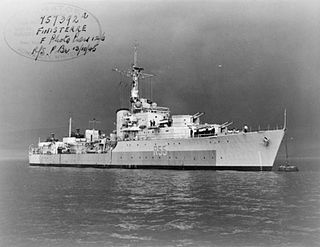
HMS Finisterre was a Battle-class destroyer of the Royal Navy (RN). She was named after one of the battles of Cape Finisterre. She was the first and thus far the only ship of the Royal Navy to bear this name.
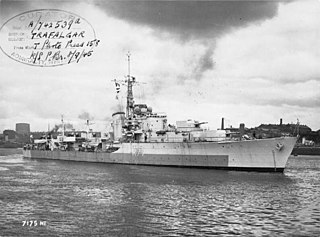
HMS Trafalgar was a Battle-class destroyer of the Royal Navy (RN). She was named after the Battle of Trafalgar, a decisive British victory over a Franco-Spanish Fleet in 1805. Trafalgar was built by Swan Hunter on the Tyne. She was launched on 12 January 1944 and commissioned on 23 July 1945.
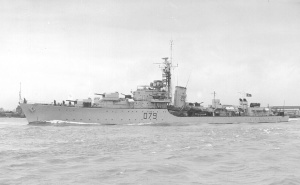
HMS Cadiz was a Battle-class destroyer of the Royal Navy. She was named after the Battle of Cádiz, in which the French besieged the Spanish town in 1810, which was eventually lifted in 1812 after the French defeat at the Battle of Salamanca.

HMS Barrosa (D68) was a later or 1943 Battle-class fleet destroyer of the Royal Navy.
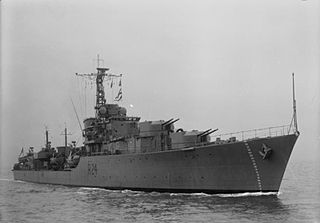
HMS Gravelines was a Battle-class destroyer of the Royal Navy. She was named after the Battle of Gravelines, which took place in 1588, resulting in the English Navy defeating the Spanish Armada. Gravelines was built by Cammell Laird of Birkenhead. She was laid down on 10 August 1943, launched on 30 November 1944 and completed on 14 June 1946.

HMS Solebay was a Battle-class destroyer of the Royal Navy (RN). She was named after the Battle of Solebay which took place in 1672 between an Anglo-French force and the Dutch Navy during the Third Anglo-Dutch War. Solebay was built by R. & W. Hawthorn, Leslie & Company Limited on the Tyne. She was launched on 22 February 1944 and commissioned on 25 September 1945.

HMS Broadsword was a Weapon-class destroyer of the British Royal Navy in service from 1948 and scrapped in 1968.

HMS Scorpion was a Weapon-class destroyer of the British Royal Navy in service from 1947 and scrapped in 1971. Originally named Centaur, the ship was renamed Tomahawk and finally Scorpion before her launch.
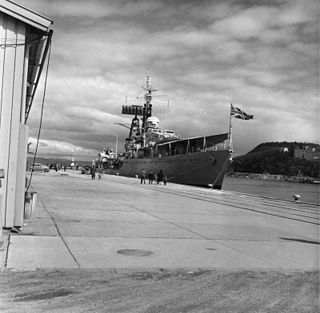
HMS Crossbow was a Weapon-class destroyer of the Royal Navy that was in service from 1948 and scrapped in 1972.

HMS Rocket was an R-class destroyer of the Royal Navy that saw service during Second World War. Built by Scotts Shipbuilding and Engineering Company in Greenock, Scotland, she was launched in October 1942 and commissioned in August 1943.

HMS Relentless was an R-class destroyer of the Royal Navy that saw service during World War II. She was later converted into a Type 15 fast anti-submarine frigate, with the new pennant number F185.
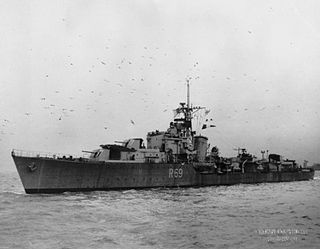
HMS Ulysses was a U-class destroyer of the British Royal Navy that saw service during World War II. She was later converted into a Type 15 fast anti-submarine frigate, with the new pennant number F17.

HMS Carysfort was a C-class destroyer of the Royal Navy. She was ordered in 1941, originally under the name HMS Pique.

HMS Chieftain was a C-class destroyer of the Royal Navy that was in service from March 1946, and which was scrapped in 1961.
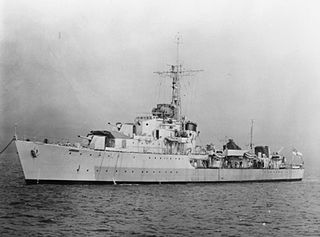
HMS Chequers was a C-class destroyer, of the "Ch" subclass, of the Royal Navy that was in service from December 1945, and which was scrapped in 1966.

HMS Myngs was a Z-class destroyer of the Royal Navy built as a flotilla leader by Vickers-Armstrong, Tyneside. She served during the Second World War, participating in operations in the North Sea and off the Norwegian coast, before taking part in some of the Arctic convoys. She spent a further ten years in Royal Navy service after the end of the war, before being sold to the Egyptian Navy, which operated her as El Qaher. She was sunk in an Israeli air attack on 16 May 1970.

HMS Crispin was a C-class destroyer of the Royal Navy built by J. Samuel White, Cowes between 1944 and 1946. She was originally to have been named HMS Craccher. She was sold to the Pakistan Navy in 1958 and renamed PNS Jahangir. She was scrapped in 1982.
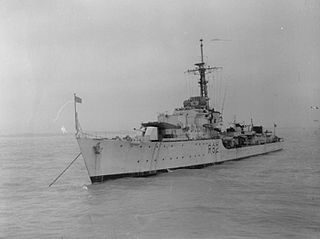
HMS Creole was a C-class destroyer of the Royal Navy built by J. Samuel White, Cowes between 1944 and 1946. She was sold to the Pakistan Navy in 1958 and renamed PNS Alamgir. She was scrapped in 1982.

HMS Comus was a C-class destroyer of the Royal Navy, built by Yarrow at Scotstoun, Glasgow. She was launched on 24 August 1943 and commissioned on 20 December 1946.

HMS Comet was one of thirty-two C-class destroyers built for the Royal Navy during the Second World War, a member of the eight-ship Co sub-class.




















